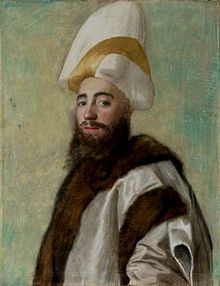Hekimoğlu Ali Pasha

Hekimoğlu Ali Pascha (* 1689 in Istanbul ; † 13 August 1758 in Kütahya ) was an Ottoman statesman and military commander. He served several times as provincial governor and grand vizier of the Ottoman Empire .
Life
Origin, education and first years as provincial governor
Ali was born in 1689 as the son of the Venetian Hekimbaşı Nuh Efendi , who converted from Christianity to Islam and worked as a doctor in Istanbul. His mother Safiye was of Turkish descent. Ali's nickname Hekimoğlu means son of a doctor in Turkish . After his training, he entered the service of the Sultan's Palace and rose to Kapıcıbaşı .
Ali then worked as governor ( beylerbey ) in Zile , in Eyâlet Adana and in Eyâlet Aleppo . During the Ottoman-Persian War from 1722 to 1727 he conquered the city of Tabriz as commander . After the Treaty of Hamedan in 1727, Ali was then governor of Eyâlet Shahrizor (in present-day Iraq ) and of Eyâlet Rûm . During the renewed war against Persia, he served as a front commander ( Turkish Serdar ). He conquered Urmia and Tabriz again, then became governor of Eyâlet Egypt . His successor in this capacity was his son-in-law Hatibzade Yahya Pascha .
First term as Grand Vizier
During his first tenure from March 12, 1732 to August 12, 1735, he tried to reform the Ottoman army and founded the new artillery corps of Humbaracı . For this he hired the French-born convert Claude Alexandre de Bonneval , who later became known as Humbaracı Ahmed Pascha and contributed decisively to the Austrian defeat at Niš in the Russo-Austrian Turkish War (1736–1739). Ali Pasha was suspicious of the Russian Empire and tried to end the war against Persia to free up resources, but his peace policy met with criticism and he was sacked during a council of war at the palace of Sultan Mahmud I.
After his release, Ali Pasha returned to the service of provincial governor. He served in Crete , in Eyâlet Bosnia , in Eyâlet Egypt and in Anatolia. In Bosnia he defeated the Austrians in the Battle of Banja Luka in the Russo-Austrian Turkish War and supported Grand Vizier İvaz Mehmet Pasha in the siege and conquest of Belgrade (1739). In Egypt he suppressed the beginning of the Mamluks uprisings in 1740.
Second term as Grand Vizier
During his second term as Grand Vizier from April 21, 1742 to September 23, 1743, his biggest problem was the new war against the Persian Empire waged by Nadir Shah of the Afsharid dynasty . However, the Sultan rejected Ali Pasha's plans for a campaign and dismissed him for failing to take adequate measures on the Eastern Front.
Even after his second term in office, Ali Pasha returned to the service of governor and worked in Lesbos and Crete, in Bosnia, Trikala (now Greece), Ochakiv (now Ukraine ), Vidin (now Bulgaria ) and Trabzon . In Trabzon he was able to end the chaos through local leaders and enforce the Ottoman order.
Third term as Grand Vizier
The third term as Grand Vizier was very short and lasted from February 15, 1755 to May 18, 1755. When Ali Pasha refused, on the instructions of Sultan Osman III. killing a young prince the sultan imprisoned him. He escaped execution only through the intercession of the Valide Sultan (Sultan's mother) Şehsuvar .
After his incarceration in Kızkulesi , he was banished first to Famagusta in Cyprus and then to the island of Rhodes . In 1756 he was pardoned and for the second time governor of Eyâlet Egypt. His term of office is described as peaceful. On October 17, 1757 he became governor of Anatolia for the fourth time .
death
Ali Pascha died on August 13, 1758 in Kütahya of an infection of the urogenous tract. He was buried in a tomb at the Hekimoğlu Ali Pasha Mosque in Istanbul.
Individual evidence
- ↑ a b c d e f g h i j Hekimoğlu Ali Paşa , TDV Islam Ansiklopedisi, Türkiye Diyanet Vakfı, accessed on April 27, 2020
- ↑ Yaşar Yüce, Ali Sevim: Türkiye tarihi , Volume IV, AKDTYKTTK Yayınları, Istanbul 1991, p. 15
- ↑ Yüce, Sevim (1991), p. 6
- ↑ Abd al-Rahman Jabarti, Thomas Philipp, Moshe Perlmann: Abd Al-Rahmann Al-Jabarti's History of Egypt . Volume 1, Franz Steiner Verlag, Stuttgart 1994, p. 247
- ^ Ayhan Buz: Osmanlı Sadrazamları . Neden Kitap, Istanbul 2009, ISBN 978-975-254-278-5 , pp. 204f.
- ↑ Yüce, Sevim (1991), p. 33
- ↑ Jabarti, Philipp, Perlmann (1994), p. 308
| predecessor | Office | successor |
|---|---|---|
| Topal Osman Pasha |
Grand Vizier of the Ottoman Empire March 12, 1732 - August 12, 1735 |
Gürcü İsmail Pasha |
| Nişancı Ahmed Pasha | Grand Vizier of the Ottoman Empire April 21, 1742 - September 23, 1743 |
Seyyid Hasan Pasha |
| Çorlulu Köse Bahir Mustafa Pasha | Grand Vizier of the Ottoman Empire February 15, 1755 - May 18, 1755 |
Naili Abdullah Pasha |
| personal data | |
|---|---|
| SURNAME | Hekimoğlu Ali Pasha |
| BRIEF DESCRIPTION | Ottoman statesman and military commander |
| DATE OF BIRTH | 1689 |
| PLACE OF BIRTH | Istanbul |
| DATE OF DEATH | August 13, 1758 |
| Place of death | Kutahya |